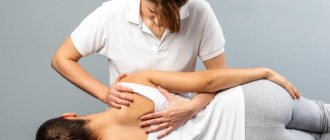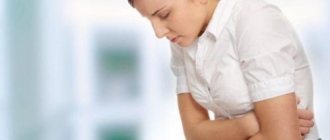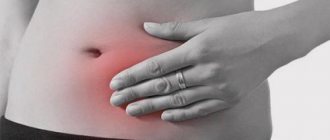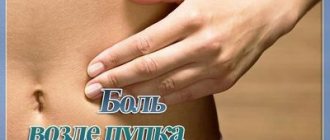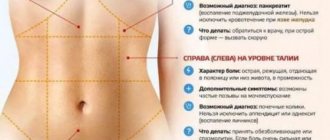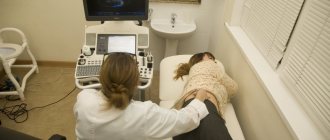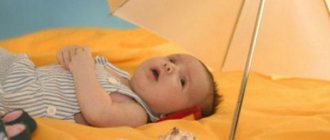Testicular pain in men is usually accompanied by pain in the groin area. The most common cause of this symptom is prostatitis - acute or chronic inflammation of the prostate gland. In addition to pain, a man experiences urinary disturbances: pain, burning, false urges, weakening of the urine stream.
Sharp pain can occur with testicular torsion associated with sudden movements during sports. Half of the scrotum quickly increases in size due to swelling, the temperature rises, nausea and vomiting occur.
Other possible reasons why the testicles and abdomen hurt:
- epididymitis and orchitis (inflammation of the epididymis);
- spermatocele (spermatic cord cyst, which is more common in old age);
- inguinal hernia, congenital or acquired;
- sexually transmitted infections (for example, if you recently had casual sexual intercourse);
- adenoma or malignant tumor of the prostate;
- hydrocele (serous fluid between the membranes of the testicle).
Strong excitement
Another reason could be severe overexcitation, after which there was no ejaculation. Due to the fact that the seminal fluid is not released, a strong spasm occurs, manifested by pain. Fullness of the testicles causes unpleasant symptoms. But the pain here is not sharp, but aching and pulling.
The physiological nature of the symptom, which does not require urgent medical attention, is indicated by the following signs:
- the pain is nagging, moderate and not accompanied by general malaise or fever;
- there are no rashes, redness, or swelling on the skin of the scrotum;
- the process of urination is not disturbed, the color of urine is not changed.
Pain in the testicles - causes
The testicles are very sensitive to touch, so even the slightest blow or injury can cause pain and discomfort.
Causes of pain:
- trauma – edema (swelling), possible hematoma (bruise or collection of blood);
- testicular torsion (a consequence of rotation of the testicles with interruption of blood flow) - severe, one-sided and constant pain, sudden onset of pain, asymmetrical, transversely high testicles;
- testicular torsion - gradual onset of pain over several days, pain in the upper part of the testicle, the appearance of blue or black spots under the skin in the upper part of the testicle (typical for boys aged 7 to 14 years);
- epididymitis (inflammation of the testicles) - sudden or gradual pain in the epididymis, sometimes in the testicles themselves, possibly more frequent urination, edema (swelling), erythema (redness of the skin);
- orchitis (inflammation of the testicles) - pain in the abdomen and scrotum, nausea, fever; unilateral or bilateral edema (swelling), erythema (redness) of the scrotum;
- consequences of a recent vasectomy;
- side effects of certain antibiotics or chemotherapy;
- testicular hernia - pain in the testicle, enlarged testicle, bulge in the scrotum;
- kidney stones - pain may progress to the testicles;
- testicular injury (from a blow) - transient pain, swelling (swelling, possible hematoma);
- testicular infections - affect one or both testicles and can be bacterial or viral; pain, swelling and erythema, and sensitivity to touch occur.
Inguinal hernia
Inguinal hernia in men often affects the testicles (27% of cases). It is a protrusion of the contents of the abdominal cavity through the inguinal canal.
Symptoms of inguinal hernia:
- bulge on testicle;
- dull pain or discomfort in the testicles;
- worsening symptoms due to coughing, sneezing, or lifting.
An inguinal hernia is removed surgically.
Testicular torsion or testicular torsion
Testicular torsion often affects only one testicle and is accompanied by severe pain. This occurs because the connective tissue that holds the testicles firmly in the scrotum weakens, and they then begin to move freely. Some boys are born with weakened connective tissue, and in some men the condition is caused by injury.
The injury can occur suddenly, during sleep, or during exercise or physical activity. Most often occurs during puberty due to rapid growth.
Symptoms:
- sudden severe pain, often in only one testicle;
- swelling and swelling;
- high testicle (the affected part is asymmetrical);
- nodules and protrusions in the scrotum;
- nausea and vomiting.
Testicular torsion is detected during physical examination and ultrasound. Treated surgically (by returning to the physical position and fixing).
Epididymitis
is an inflammation of the epididymis or testicles. Epididymitis is widespread among all age groups, but especially among boys and men aged 14 to 35 years. The most common causes of this inflammation are sexually transmitted diseases, bacterial infections, or result from chemical irritation due to urine returning to the epididymis.
Bacterial infections causing epididymitis:
- chlamydia;
- gonorrhea;
- urinary tract infection;
- prostate infection.
Symptoms:
- pain in the testicles to the touch;
- testicular pressure;
- redness;
- edema (swelling);
- possible fever;
- possible pain when urinating;
- frequent urination.
Stages of diagnosing epididymitis:
- physical examination (swelling, redness, sensitivity to touch);
- urethral smear;
- blood analysis;
- Ultrasound;
- Analysis of urine.
The infection is treated with antibiotics. There are also several ways to relieve pain:
- bed rest;
- keep ice packs on the painful area;
- avoid lifting heavy objects;
- holding the scrotum in an elevated position for some time.
Kidney (urinary) stone
Kidney stones are formed from mineral salts contained in urine. These are small, hard deposits that can cause severe pain. Sometimes the stones can reach the urethra (urinary tract), where they stop the flow of urine. They then cause pain and possible infections.
Symptoms:
- painful urination;
- nausea and vomiting;
- if the testicle is affected - pain on palpation;
- hematuria (blood in the urine - reddish color of urine);
- frequent urge to urinate;
- the pain spreads to the lower back and groin.
Varicocele
Varicocele is a condition of dilated veins in the scrotum. In boys and teenagers, it can cause infertility or abnormal development of the testicles. It is unclear what exactly causes varicoceles, but they most often occur during puberty.
Veins form near both testicles, and varicoceles often appear on the left side due to the location of the left testicular veins.
Varicoceles often cause no symptoms, but may cause pain that:
- changes from sharp pain to dull pain;
- worsens over time;
- increases with physical activity.
They are detected during a physical examination by a doctor or an ultrasound examination. If the varicocele has not spread too much, treatment will not be necessary. If it has spread, a laparoscopic procedure may be performed in which the affected veins are cut or sealed.
Varicoceles can cause infertility or compression of the affected testicle.
Mumps (mumps)
Mumps is a contagious viral infection that causes enlargement of the salivary glands. The causative agent is a virus from the mumps family.
Symptoms of mumps:
- swelling or tenderness of the glands under the ears (appearance of swollen cheeks);
- fever (38°C to 40°C);
- headache;
- earache;
- a sore throat;
- loss of appetite;
- pain when eating acidic foods or drinks.
Mumps is a highly contagious disease, but once a person overcomes it, they remain immune to it forever. Mumps is treatable, but if not treated promptly, it can cause:
- encephalitis – inflammation of the brain caused by a viral infection;
- meningitis - inflammation of the brain and meninges;
- orchitis is an inflammation of the testicles that can cause infertility. Orchitis also causes pain in the testicles.
Orchitis (inflammation of the testicles)
Orchitis is inflammation of one or both testicles. This manifests itself as painful swelling of the testicles.
This may be caused by:
- chlamydia;
- gonorrhea;
- mumps;
- epididymitis
- other infections.
The symptoms of orchitis are as follows:
- swelling of one or both testicles;
- moderate to severe pain in the testicles to the touch;
- sensitivity of the testicles to touch;
- heat;
- nausea and vomiting.
If a bacterial infection is excluded, symptomatic treatment with compresses and analgesics is sufficient. Bacterial forms are treated with antibiotics.
Testicular cancer
Testicular cancer is the most common form of cancer in men aged 15 to 35 years. It begins with a growth in the scrotum, which can be painful, but more often painless.
It is most often treatable if detected and treated early. Symptoms of testicular cancer:
- nodules on the testicles;
- enlarged or reduced testicles;
- hardening of the testicles;
- pain in the groin and lower abdomen;
- accumulation of fluid in the scrotum - hydrocele;
- feeling of heaviness in the scrotum.
Regular self-examination is important to detect symptoms of the disease in time.
Why does a man's right or left testicle hurt?
The most common cause of pain in the left testicle in men is varicocele - dilation of the veins of the spermatic cord. In 80% of cases, the disease manifests itself on the left side. For this reason, the pain radiates to the left testicle. It can also hurt with pyelonephritis, urolithiasis and intestinal infections.
Pain in the right testicle in men is associated with torsion of the spermatic cord. Varicocele occurs on the right side less often than on the left, but the possibility cannot be completely excluded. Also, pain can occur for any of the reasons listed above if the inflammation affects only the right testicle.
Treatment of testicular pain
Testicular pain is treated primarily by identifying and determining the cause of the condition. Often this treatment depends on the specific disease, so antibiotics are used for infections.
Treatment includes:
- visiting a medical facility;
- physical examination;
- ultrasonography;
- blood and urine tests;
- use of antibiotics;
- peace;
- ice packs (cold compresses);
- surgical operations.
Which doctor should I contact if my testicle hurts?
If you encounter such a symptom, you need to contact a urologist or andrologist. The competence of these specialists includes the diagnosis and treatment of diseases of the genitourinary and reproductive systems. At the clinic Dr. AkNer employs specialists with extensive experience, and also has all the necessary equipment for a complete examination. Already at the initial consultation you will understand the tactics of diagnosis and subsequent treatment. To make an appointment, write to us in the online form or call our contact numbers at a convenient time.
Diagnostics
The cause of pain in the scrotum is determined by a urologist-andrologist. During a conversation with the patient, the doctor establishes the circumstances and time of onset of the symptom, and monitors the dynamics of the development of the disease. To clarify the diagnosis, the following procedures are performed:
- Physical examination
. The specialist examines the external genitalia, detects an increase in volume, tissue swelling, changes in skin color and temperature, dilated veins, and other manifestations. Palpates the scrotum and regional lymph nodes to assess the condition of the testicle, epididymis and spermatic cord, and detect lymphadenitis. - Rectal examination.
It is carried out to exclude space-occupying formations and inflammatory processes of the prostate gland. - Diaphanoscopy.
X-raying of the scrotum is performed during the appointment, allowing for preliminary differentiation of hydrocele and other conditions with enlargement of the scrotum (tumors, hernia, edema, inflammation, elephantiasis). - Ultrasound of the scrotum.
A safe and painless procedure used to detect torsion, varicocele, neoplasms, inflammatory processes, and other pathologies. According to indications, it is supplemented with Doppler sonography. - Scintigraphy.
Used in the diagnosis of injuries, tumors, vascular diseases, and inflammatory diseases. A dynamic study is prescribed to assess the function and blood flow of the testicles, a static study is prescribed to identify structural pathologies. - Scrotal puncture.
Performed for hydrocele and spermatocele for differential diagnosis of these conditions with tumors, hernias, and hematocele. - Lab tests
. To determine the activity of inflammation and detect anemia in injuries and cancer, general blood tests are prescribed. To detect kidney pathologies, urine tests are performed. If an STI is suspected, PCR is performed. Points and biopsies are sent for cytological or histological examination. According to indications, a spermogram is taken.
How to treat pain in the testes
In order to relieve pain, painkillers are used, but when prescribing them, it is necessary to take into account the individual characteristics of the patient.
If the painful condition is caused by gonorrhea or another infectious disease, then antibiotics are used for treatment. But you shouldn’t prescribe treatment for yourself on the basis that it helped your friend. Only a doctor can choose the right treatment, having first conducted a full examination of the patient and established the cause of the pain.
